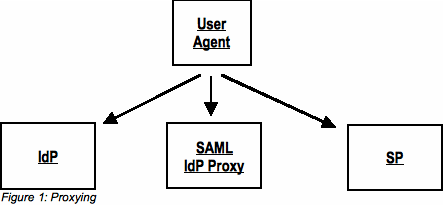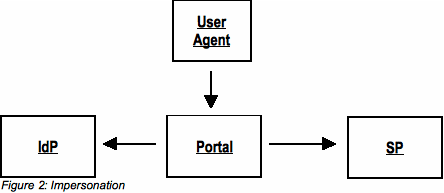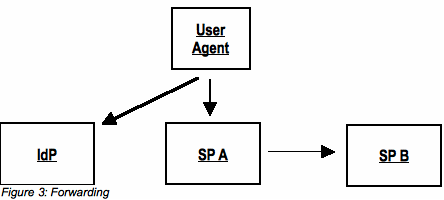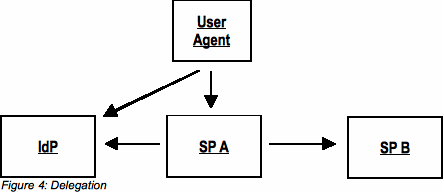

SAML V2.0 Condition for Delegation Restriction Version 1.0
Committee Specification 01
15 November 2009
Specification URIs:
This Version:
http://docs.oasis-open.org/security/saml/Post2.0/sstc-saml-delegation-cs-01.html
http://docs.oasis-open.org/security/saml/Post2.0/sstc-saml-delegation-cs-01.odt (Authoritative)
http://docs.oasis-open.org/security/saml/Post2.0/sstc-saml-delegation-cs-01.pdf
Previous Version:
http://docs.oasis-open.org/security/saml/Post2.0/sstc-saml-delegation-cd-02.html
http://docs.oasis-open.org/security/saml/Post2.0/sstc-saml-delegation-cd-02.odt (Authoritative)
http://docs.oasis-open.org/security/saml/Post2.0/sstc-saml-delegation-cd-02.pdf
Latest Version:
http://docs.oasis-open.org/security/saml/Post2.0/sstc-saml-delegation.html
http://docs.oasis-open.org/security/saml/Post2.0/sstc-saml-delegation.odt (Authoritative)
http://docs.oasis-open.org/security/saml/Post2.0/sstc-saml-delegation.pdf
Technical Committee:
Chair(s):
Hal Lockhart, Oracle Corporation
Thomas Hardjono, M.I.T.
Editors:
Scott Cantor, Internet2
Declared XML Namespace(s):
urn:oasis:names:tc:SAML:2.0:conditions:delegation
Abstract:
This document defines a <saml:Condition> type for expressing a chain of intermediaries acting on behalf of the subject of an assertion, requring relying parties to distinguish between direct and indirect access.
Status
This document was last revised or approved by the SSTC on the above date. The level of approval is also listed above. Check the current location noted above for possible later revisions of this document. This document is updated periodically on no particular schedule.
TC members should send comments on this specification to the TC’s email list. Others should send comments to the TC by using the “Send A Comment” button on the TC’s web page at http://www.oasis-open.org/committees/security.
For information on whether any patents have been disclosed that may be essential to implementing this specification, and any offers of patent licensing terms, please refer to the IPR section of the TC web page (http://www.oasis-open.org/committees/security/ipr.php).
The non-normative errata page for this specification is located at http://www.oasis-open.org/committees/security.
Notices
Copyright © OASIS Open 2009. All Rights Reserved.
All capitalized terms in the following text have the meanings assigned to them in the OASIS Intellectual Property Rights Policy (the "OASIS IPR Policy"). The full Policy may be found at the OASIS website.
This document and translations of it may be copied and furnished to others, and derivative works that comment on or otherwise explain it or assist in its implementation may be prepared, copied, published, and distributed, in whole or in part, without restriction of any kind, provided that the above copyright notice and this section are included on all such copies and derivative works. However, this document itself may not be modified in any way, including by removing the copyright notice or references to OASIS, except as needed for the purpose of developing any document or deliverable produced by an OASIS Technical Committee (in which case the rules applicable to copyrights, as set forth in the OASIS IPR Policy, must be followed) or as required to translate it into languages other than English.
The limited permissions granted above are perpetual and will not be revoked by OASIS or its successors or assigns.
This document and the information contained herein is provided on an "AS IS" basis and OASIS DISCLAIMS ALL WARRANTIES, EXPRESS OR IMPLIED, INCLUDING BUT NOT LIMITED TO ANY WARRANTY THAT THE USE OF THE INFORMATION HEREIN WILL NOT INFRINGE ANY OWNERSHIP RIGHTS OR ANY IMPLIED WARRANTIES OF MERCHANTABILITY OR FITNESS FOR A PARTICULAR PURPOSE.
OASIS requests that any OASIS Party or any other party that believes it has patent claims that would necessarily be infringed by implementations of this OASIS Committee Specification or OASIS Standard, to notify OASIS TC Administrator and provide an indication of its willingness to grant patent licenses to such patent claims in a manner consistent with the IPR Mode of the OASIS Technical Committee that produced this specification.
OASIS invites any party to contact the OASIS TC Administrator if it is aware of a claim of ownership of any patent claims that would necessarily be infringed by implementations of this specification by a patent holder that is not willing to provide a license to such patent claims in a manner consistent with the IPR Mode of the OASIS Technical Committee that produced this specification. OASIS may include such claims on its website, but disclaims any obligation to do so.
OASIS takes no position regarding the validity or scope of any intellectual property or other rights that might be claimed to pertain to the implementation or use of the technology described in this document or the extent to which any license under such rights might or might not be available; neither does it represent that it has made any effort to identify any such rights. Information on OASIS' procedures with respect to rights in any document or deliverable produced by an OASIS Technical Committee can be found on the OASIS website. Copies of claims of rights made available for publication and any assurances of licenses to be made available, or the result of an attempt made to obtain a general license or permission for the use of such proprietary rights by implementers or users of this OASIS Committee Specification or OASIS Standard, can be obtained from the OASIS TC Administrator. OASIS makes no representation that any information or list of intellectual property rights will at any time be complete, or that any claims in such list are, in fact, Essential Claims.
The name "OASIS" is a trademark of OASIS, the owner and developer of this specification, and should be used only to refer to the organization and its official outputs. OASIS welcomes reference to, and implementation and use of, specifications, while reserving the right to enforce its marks against misleading uses. Please see http://www.oasis-open.org/who/trademark.php for above guidance.
Table of Contents
1 Introduction 5
1.1 Notation 5
1.2 Normative References 6
1.3 Non-Normative References 6
2 SAML V2.0 Condition for Delegation Restriction 7
2.1 Required Information 7
2.2 Overview 7
2.2.1 Terminology and Motivation 7
2.3 Element <Delegate> 9
2.4 Complex Type DelegationRestrictionType 10
2.5 Use of Identifiers Within <saml:SubjectConfirmation> 10
2.6 Security Considerations 11
3 Conformance 12
3.1 SAML V2.0 Condition for Delegation Restriction 12
Appendix A. Acknowledgements 13
Appendix B. Revision History 14
Some advanced SAML use cases involve a single logical transaction that spans one or more intermediate clients or servers. A common example includes a SAML-enabled web site acting on behalf of a logged-in user while accessing additional SAML-enabled web services. Generalizing this example, a number of intermediaries might be transited before the final point of access. If a SAML assertion is used as a security token to authenticate and authorize such access, it is important that the identity and order of intermediaries, if any, be expressed within the token in some fashion.
Existing mechanisms designed for this purpose, such as the <saml:SubjectConfirmation> element definition in the SAML V2.0 core specification [SAML2Core], or the extended syntax found in the Liberty ID-WSF Security Mechanisms specification [LibSecMech20], suffer from the drawback that they have advisory semantics for a relying party and are likey to be ignored by delegation-unaware SAML processing. While backward compatibility can be an advantage, ignoring security-relevant details that might impact upon a relying party's policy is unacceptable in some scenarios.
This specification provides for the expression of delegation information with normative SAML processing semantics through the use of a <saml:Condition> extension type.
This specification uses normative text.
The keywords "MUST", "MUST NOT", "REQUIRED", "SHALL", "SHALL NOT", "SHOULD", "SHOULD NOT", "RECOMMENDED", "MAY", and "OPTIONAL" in this specification are to be interpreted as described in [RFC2119]:
…they MUST only be used where it is actually required for interoperation or to limit behavior which has potential for causing harm (e.g., limiting retransmissions)…
These keywords are thus capitalized when used to unambiguously specify requirements over protocol and application features and behavior that affect the interoperability and security of implementations. When these words are not capitalized, they are meant in their natural-language sense.
Listings of XML schemas appear like this.
Example code listings appear like this.
Conventional XML namespace prefixes are used throughout the listings in this specification to stand for their respective namespaces as follows, whether or not a namespace declaration is present in the example:
|
Prefix |
XML Namespace |
Comments |
|---|---|---|
|
saml: |
urn:oasis:names:tc:SAML:2.0:assertion |
This is the SAML V2.0 assertion namespace defined in the SAML V2.0 core specification [SAML2Core]. |
|
del: |
urn:oasis:names:tc:SAML:2.0:conditions:delegation |
This is the namespace defined by this specification. |
|
xsd: |
http://www.w3.org/2001/XMLSchema |
This namespace is defined in the W3C XML Schema specification [Schema1]. In schema listings, this is the default namespace and no prefix is shown. |
|
xsi: |
http://www.w3.org/2001/XMLSchema-instance |
This is the XML Schema namespace for schema-related markup that appears in XML instances [Schema1]. |
This specification uses the following typographical conventions in text: <SAMLElement>, <ns:ForeignElement>, Attribute, Datatype, OtherCode.
[Delegation-XSD] OASIS Committee Draft 02, SAML V2.0 Condition for Delegation Restriction Schema, September 2009. http://docs.oasis-open.org/security/saml/Post2.0/sstc-saml-delegation.xsd
[RFC2119] S. Bradner. Key words for use in RFCs to Indicate Requirement Levels. IETF RFC 2119, March 1997. http://www.ietf.org/rfc/rfc2119.txt
[SAML2Core] OASIS Standard, Assertions and Protocols for the OASIS Security Assertion Markup Language (SAML) V2.0, March 2005. http://docs.oasis-open.org/security/saml/v2.0/saml-core-2.0-os.pdf
[Schema1] H. S. Thompson et al. XML Schema Part 1: Structures. World Wide Web Consortium Recommendation, May 2001. http://www.w3.org/TR/2001/REC-xmlschema-1-20010502/
[Schema2] Paul V. Biron, Ashok Malhotra. XML Schema Part 2: Datatypes. World Wide Web Consortium Recommendation, May 2001. http://www.w3.org/TR/2001/REC-xmlschema-2-20010502/
[LibSecMech20] F.Hirsch. Liberty ID-WSF Security Mechanisms Core. November 2006. http://www.projectliberty.org/specs
Identification: urn:oasis:names:tc:SAML:2.0:conditions:delegation
Contact information: security-services-comment@lists.oasis-open.org
The SAML V2.0 core specification [SAML2Core] defines the saml:ConditionAbstractType complex type as a basis for extensions with mandatory processing semantics for relying parties. This specification defines such an extension as a supplement for the presence of an identifier within the <saml:SubjectConfirmation> element.
Rather than an advisory mechanism for identifying a single delegate, the extension provides for a normative mechanism that identifies an ordered sequence of delegates, along with optional detail about the acts of delegation.
Delegation can be complex and is frequently conflated, combined, or confused with a number of related approaches. Without attempting to address all the myriad ways of describing such interactions, for the purposes of this profile the following is an attempt to capture some of the alternatives encountered and how the notion of delegation is meant for the purposes of this profile. In most of the cases presented, the flows involved are simplified for illustration. These are not meant as normative scenarios.
Proxying
As described by section 3.4.1.5 of the SAML V2.0 core specification [SAML2Core], proxying occurs when an intermediate identity provider issues an assertion to a relying party on the basis of an assertion issued to it. Proxying is a gateway-like function in which the subect of the assertion is presumed to directly interact with each party directly.

In Figure 1: Proxying, the sequence proceeds from left to right, with the user agent authenticating to the left-most system to obtain an assertion for the proxy, which issues an assertion for the user agent to deliver to the service.
Impersonation
An impersonation model is one in which an entity acting on behalf of an assertion subject is able to obtain and use an assertion indistinguishable from an assertion that would be issued directly to the subject. A typical example of such a scenario might include a portal that holds credentials for users and is able to authenticate directly to obtain assertions about them.

In Figure 2: Impersonation, the user agent supplies its credentials (e.g., a password) to the portal, which relays them to the identity provider on the left, obtaining an assertion that it supplies to the service. As far as the service knows, the portal is a direct user agent.
Forwarding
Forwarding is a form of impersonation in which an assertion is directly reused by an intermediary to impersonate a subject from whom an assertion was obtained. It is distinguished from delegation in that assertions are passed along unchanged, and because (as an impersonation model) the assertion is not modified in a fashion that would identify the intermediary.

In Figure 3: Forwarding, the user agent authenticates directly to the identity provider, obtaining an assertion that it delivers to the service in the middle. The service directly forwards the assertion to the second service on the right, acting as the subject. As far as the second service knows, the first service is a direct user agent (as with impersonation).
Delegation
Finally, delegation moves beyond the forwarding scenario by adding information to the assertion that explicitly identifies all the parties through which a transaction flows. While it is ultimately a matter for the identity provider as to how and on what basis this information is collected, it is often assured by routing requests back through the identity provider at each hop to cryptographically guarantee that each party has been authenticated and appropriate policy enforced. This fine-grained and real-time enforcement capability is a key advantage over pure forwarding or impersonation.

In Figure 4: Delegation, the forwarding model is extended by adding a request back to the identity provider by the intermediary service in the middle. This allows a new assertion to be issued to it that, while it may identify the same subject as the original, also identifies the service as a delegate of the subject. This identification can be performed advisedly, in a manner defined by [SAML2Core], or with a normative semantic as defined by this profile.
So, in summary, this profile is intended to address scenarios in which assertions are materially altered to reflect the path of a transaction through one or more intermediaries that act on behalf of the subject of the assertion. These intermediaries are termed delegates, and an assertion carrying the condition type defined in this profile is termed a delegate assertion. The act of producing such an assertion is then termed delegation and we can say that the credentials from which the assertion is derived have been delegated. Such credentials are therefore delegatable. In the context of SAML, an assertion might be used as a delegatable credential, so it's possible in multiple-tier scenarios for a delegate assertion to itself be delegatable.
There are no normative requirements associated with the use of these terms, and they do not materially affect the semantics of the profile, but using terms consistently across implementations and scenarios is likely to aid understanding and deployment.
The <Delegate> element is a container for a single intermediary/delegate represented by the assertion. It contains the following elements and attributes:
DelegationInstant [Optional]
A timestamp indicating the approximate time at which the act of delegation occurred, if known.
ConfirmationMethod [Optional]
Identifies the subject confirmation method used, if the delegate presented a SAML assertion to authenticate itself to the issuing authority.
<saml:BaseID>, <saml:NameID>, <saml:EncryptedID> [Required]
Identifies the delegate.
The delegate is identified by a required child element in the usual SAML fashion. The optional attributes, if present, supply additional information about the act of delegation.
The following schema fragment defines the <Delegate> element and its DelegateType complex type:
<element name="Delegate" type="del:DelegateType"/>
<complexType name="DelegateType">
<choice>
<element ref="saml:BaseID"/>
<element ref="saml:NameID"/>
<element ref="saml:EncryptedID"/>
</choice>
<attribute name="DelegationInstant" type="dateTime" use="optional"/>
<attribute name="ConfirmationMethod" type="anyURI" use="optional"/>
</complexType>
The DelegationRestrictionType complex type defines a subtype of saml:ConditionType representing one or more acts of delegation that are represented by the containing assertion. It contains the following elements:
<Delegate> [One or more]
An element identifying a delegate of the subject of the containing assertion. The delegates MUST be ordered from least to most recent; thus the earliest element is the farthest removed from the immediate use of the assertion.
A relying party MUST evaluate the list of delegates, and SHOULD NOT accept the assertion unless it wishes to permit each delegate to act on behalf of the subject of the containing assertion.
A SAML authority MUST NOT include more than one <saml:Condition> element of this type within a <saml:Conditions> element of an assertion.
For the purposes of determining the validity of the <saml:Conditions> element, this condition type is always considered to be valid. That is, this condition type does not affect assertion validity, but is a condition on use.
The following schema fragment defines the DelegationRestrictionType complex type:
<complexType name="DelegationRestrictionType">
<complexContent>
<extension base="saml:ConditionAbstractType">
<sequence>
<element ref="del:Delegate" maxOccurs="unbounded"/>
</sequence>
</extension>
</complexContent>
</complexType>
For consistency with the existing SAML-defined syntax, it is RECOMMENDED that the identifier of the most recent delegate (within the last element in the condition, per section 2.4) be duplicated within the relevant <saml:SubjectConfirmation> elements in the containing assertion.
The content of this condition type is directly impacted by the security semantics of the flow of activity that leads to the issuance of the containing assertion. This specification does not define the exchanges that must take place, and relies on composition with other profiles that logically represent acts of delegation that require representation in an assertion.
Relying parties are not required to apply any particular policies with regard to the information represented by this condition type. Rather, it is expected that such information will naturally be significant in the enforcement of existing policies, and that the presence of delegation is significant enough to warrant the disruption of existing services designed to consume SAML assertions until those policies reflect a willingness to accept more indirect forms of access.
An assertion issuer conforms to this specification if it can generate assertions containing a <saml:Condition> of type DelegationRestrictionType, per section 2.
A relying party conforms to this specification if it can successfully process assertions containing a <saml:Condition> of type DelegationRestrictionType, per section 2.
The editors would like to acknowledge the contributions of the OASIS Security Services Technical Committee, whose voting members at the time of publication were:
Rob Philpott, EMC Corporation
Richard Franck, IBM
John Bradley, Individual
Scott Cantor, Internet2
Nate Klingenstein, Internet2
Bob Morgan, Internet2
Thomas Hardjono, M.I.T.
Tom Scavo, National Center for Supercomputing Applications (NCSA)
Frederick Hirsch, Nokia Corporation
Paul Madsen, NTT Corporation
Ari Kermaier, Oracle Corporation
Hal Lockhart, Oracle Corporation
Anil Saldhana, Red Hat
Kent Spaulding, Skyworth TTG Holdings Limited
Duane DeCouteau, Veterans Health Administration
David Staggs, Veterans Health Administration
Draft 01
Committee Draft 01, CD edits
Draft 02, additional explanatory text following public review
Committee Draft 02, CD edits
Sstc-saml-delegation-cs-01
15 November
2009
Copyright
© OASIS Open 2009. All Rights Reserved. Page